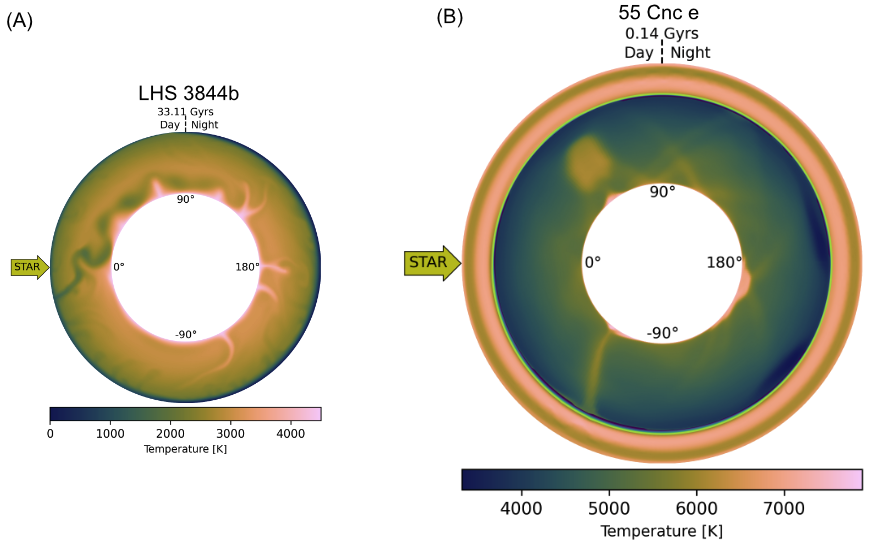Exploring the convection in super-Earths: Comparing LHS 3844b with 55 Cnc e
- 1Universität Bern, Center for Space and Habitability, Bern, Switzerland (tobias.meier@csh.unibe.ch)
- 2University of Oxford, Department of Physics, Atmospheric, Oceanic and Planetary Physics, Oxford, United Kingdom
- 3ETH Zurich, Department of Earth Sciences, Institute of Geophysics, Deparment of Earth Sciences, Zurich, Switzerland
The vigour and style of mantle convection in tidally-locked super-Earths may be substantially different from Earth's regime where the surface temperature is spatially uniform and sufficiently cold to drive downwellings into the mantle.
The thermal phase curve for super-Earth LHS 3844b suggests a solid surface and lack of a substantial atmosphere. The dayside temperature is around 1040 K and the nightside temperature is around 0 K, which is unlike any temperature contrast observed at present day for planets in the Solar System. On the other hand, the thermal phase curve of super-Earth 55 Cnc e suggests much hotter temperatures with a nightside temperature around 1380 K and a substellar point temperature around 2700 K. The substellar point is also substantially shifted eastwards, which requires efficient energy circulation in the atmosphere.
Here, we use constraints from thermal phase curve observations to model the interior mantle flow. To constrain the surface temperature of 55 Cnc e, we use the results from general circulation models varying the atmospheric composition and optical depth.
Depending on how strong the surface temperature contrast is, this can lead to hemispheric tectonic regimes. Such a regime could influence a planet's atmosphere through interior-exterior coupling mechanisms (e.g. volcanic outgassing).
We run geodynamic simulations of the interior mantle flow using the mantle convection code StagYY. The models are fully compressible with an Arrhenius-type viscosity law where the mantle is modelled with an upper mantle, a perovskite-layer and a post-perovskite layer. The lithospheric strength is modelled through a plastic yielding criteria and the heating mode is either basal heating only or mixed heating (basal and internal heating).
For LHS 3844b we find that the surface temperature dichotomy can lead to a hemispheric tectonic regime depending on the strength of the lithosphere and the heating mode in the mantle. In a hemispheric tectonic regime, downwellings occur preferentially on one side and upwellings rise on the other side (Fig. A). We compare these results to the case of 55 Cnc e, where large parts of the surface could be molten. At first order we expect that a magma ocean could homogenise the temperatures at the interface between the magma ocean and the underlying solid mantle and therefore reduce the likelihood of hemispheric tectonics operating on 55 Cnc e (Fig. B).
For LHS 3844b, the contribution of the interior flux to the thermal phase curve is on the order of 15-30 K, and therefore below the detecting capabilities of current and near-future observations. However, for hemispheric tectonics, upwellings might lead to preferential melt generation and outgassing on one hemisphere that could manifest as a secondary signal in phase curve observations. Such signals could also be produced on hotter planets such as 55 Cnc e where parts of the surface are hot enough to melt.

How to cite: Meier, T. G., Bower, D. J., Lichtenberg, T., Tackley, P. J., and Demory, B.-O.: Exploring the convection in super-Earths: Comparing LHS 3844b with 55 Cnc e, European Planetary Science Congress 2021, online, 13–24 Sep 2021, EPSC2021-500, https://doi.org/10.5194/epsc2021-500, 2021.

